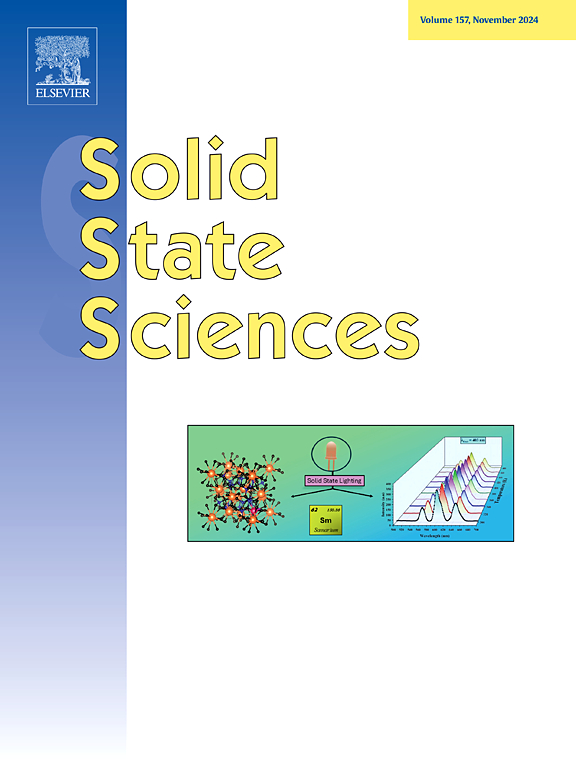Pb1−xCoxSnS3: Synthesis, structure, and magnetic properties of a series of quaternary chalcogenides
IF 3.4
3区 化学
Q2 CHEMISTRY, INORGANIC & NUCLEAR
引用次数: 0
Abstract
Quaternary metal chalcogenides, Pb1−xCoxSnS3 (x = 0.00, 0.10, 0.20, and 0.40), were synthesized from high purity elements at high temperature via sealed tube solid state synthesis method. All the compounds crystallised in the orthorhombic crystal system with Pnma space group. Single crystal study indicated that Co substitute at the Pb-site in Pb1−xCoxSnS3 in a disordered manner. The structure of Pb1−xCoxSnS3 compounds contains edge shared bi-octahedral chains of SnS6 and zig-zag chains of (Pb/Co)S running along b-direction. XPS study indicates that cobalt exists as Co2+ while tin and sulphur remain as Sn4+ and S2− respectively. Magnetic susceptibility studies on Pb1−xCoxSnS3 (x = 0.1, 0.2 and 0.40) suggest ferromagnetic ordering below 125 K. The Pb/Co-S-Pb/Co bond angle (88.6°) in the Pb/Co-S chains is very close to 90° suggesting ferromagnetic ordering in these compounds, which corroborate the magnetic susceptibility results. As the amount of Co substitution increases, the magnetic susceptibility values gradually increases as evident from the M-T curves, which is attributed to substitution of more Co2+ at the non-magnetic Pb2+ site in Pb1−xCoxSnS3. The M − H isotherms reveal saturation magnetic moment that is smaller than the expected value, possibly due to disorder of the magnetic ions in these compounds. However, neutron diffraction study is required to completely understand the detailed magnetic properties in these compounds.

求助全文
约1分钟内获得全文
求助全文
来源期刊

Solid State Sciences
化学-无机化学与核化学
CiteScore
6.60
自引率
2.90%
发文量
214
审稿时长
27 days
期刊介绍:
Solid State Sciences is the journal for researchers from the broad solid state chemistry and physics community. It publishes key articles on all aspects of solid state synthesis, structure-property relationships, theory and functionalities, in relation with experiments.
Key topics for stand-alone papers and special issues:
-Novel ways of synthesis, inorganic functional materials, including porous and glassy materials, hybrid organic-inorganic compounds and nanomaterials
-Physical properties, emphasizing but not limited to the electrical, magnetical and optical features
-Materials related to information technology and energy and environmental sciences.
The journal publishes feature articles from experts in the field upon invitation.
Solid State Sciences - your gateway to energy-related materials.
 求助内容:
求助内容: 应助结果提醒方式:
应助结果提醒方式:


